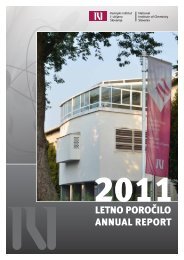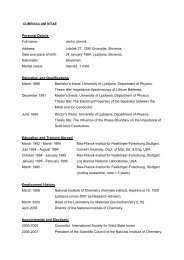Letno poročilo 2005
Letno poročilo 2005
Letno poročilo 2005
You also want an ePaper? Increase the reach of your titles
YUMPU automatically turns print PDFs into web optimized ePapers that Google loves.
Laboratorij za biotehnologijo<br />
Laboratory of Biotechnology<br />
Pripravili smo rekombinantni senzor za<br />
spremljanje kalcija, pH in proteazne aktivnosti,<br />
ki omogo~ajo in vivo spremljanje koncentracije<br />
kalcija, vrednosti pH in aktivnost citosolnih<br />
proteaz gliv. Osnovni gradniki senzorjev so<br />
zeleni fluorescirajo~i proteini. Senzor za kalcij<br />
smo v povezavi z University of Edinburgh<br />
analizirali z metodo FLIM-FRET (Förster resonance<br />
energy transfer in fluorescence lifetime<br />
imaging microscopy), ki je potrdila mo`nost<br />
uporabe omenjenega senzorja v glivah. Z<br />
rekombinatnim senzorjem za pH smo dolo~ili<br />
znotraj celi~no pH vrednost pri glivah in potrdili,<br />
da je uravnavanje znotrajceli~ne vrednosti pH<br />
povezano z uravnavanjem znotrajceli~ne<br />
koncentracije kalcija, saj pri glivah z okvarjenimi<br />
kalcijevimi ~rpalkami pride do dviga znotrajceli~ne<br />
vrednosti pH. V na{em laboratoriju smo<br />
pridobili keratinazo s fermentacijo s submeznim<br />
gojenjem glive v bioeraktorju in jo testirali pri<br />
na{ih sodelavcih v Angliji. Rezultati so pokazali,<br />
da je z encimom mo`no izbolj{ati propustnost<br />
modelne keratinske membrane. V letu <strong>2005</strong><br />
smo preizkusili okrog 100 sevov gliv na<br />
izbranem modelnem substratu za Bayer-<br />
Villigerjevo reakcijo, s katerim je mo`no pridobiti<br />
po dve stereo in dve opti~ni izomeri. [tevilne<br />
glive so bile sposobne transformirati substrat,<br />
vendar so bili produkti razli~ni. Glede na profil<br />
in opti~no ~istost dobljenih produktov smo glive<br />
lahko razvrstili v {tiri skupine.<br />
SODELOVANJE Z INDUSTRIJSKIMI<br />
IN DRUGIMI PARTNERJI<br />
- Lek, d.d., Ljubljana: raziskave na podro~ju<br />
biotehnologije ter razvoju novih zdravil<br />
- BIA Separations d.o.o, Ljubljana: dva skupna<br />
projekta<br />
MEDNARODNO SODELOVANJE<br />
mednarodni projekti:<br />
- Dva evropska projekta v okviru 5. okvirnega<br />
programa: ANTICO in ANEPID<br />
- Dva evropska projekta v okviru 6. okvirnega<br />
programa: Eurofungbase in TSEUR<br />
146<br />
activation- and inhibition in presence of different<br />
metabolites.<br />
A recombinant sensor for calcium, pH and proteolytic<br />
activity detection was prepared which<br />
enable in vivo detection of calcium concentration,<br />
pH value and activity of cytosolic proteases<br />
in fungi. Essential building blocks of the sensors<br />
are green fluorescent proteins. The calcium<br />
sensor was analyzed, in cooperation with partners<br />
from the University of Edinburgh with the<br />
FLIM-FRET (Förster resonance energy transfer<br />
in fluorescence lifetime imaging microscopy)<br />
method, confirming the possibility of application<br />
of the sensor in fungi. With the recombinant<br />
sensor for the pH we determined the<br />
intracellular pH value in fungi and we confirmed<br />
that the intracellular control was connected<br />
with the control of the intracellular calcium concentration,<br />
since in fungi with damaged calcium<br />
pumps an increase of intracellular pH occurred.<br />
In our Laboratory, a fungal keratinase<br />
was produced in a bioreactor by submerged<br />
fermentation and our British partners tested the<br />
enzyme. Results showed that by using the enzyme<br />
it was possible to increase permeability<br />
of a keratinous membrane. In <strong>2005</strong> we tested<br />
around 100 fungal strains on a selected model<br />
substrate, for Baeyer-Villiger oxidation, which<br />
enables the production of two stereo- and two<br />
optical isomers. Several fungi were able to transform<br />
the substrate. However, the obtained<br />
products were different. According to the profile<br />
and optical purity of the products the fungi<br />
could be classified into four different groups.<br />
COLLABORATION WITH INDUSTRIAL AND<br />
OTHER PARTNERS<br />
- Lek, d.d., Ljubljana, Menge{ unit, Slovenia:<br />
research of fungal metabolism and molecular<br />
biology of Streptomycetes<br />
- BIA Separations d.o.o, Ljubljana, Slovenia:<br />
two joint projects<br />
INTERNATIONAL COLLABORATION<br />
international projects:<br />
- Two projects within the 5 th Framework Programme:<br />
ANTICO in ANEPID







